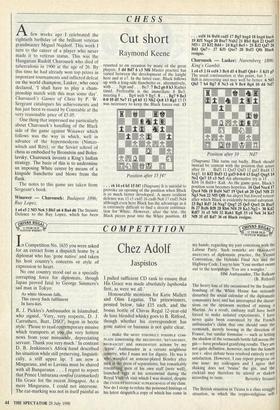CHESS
Cut short
Raymond Keene
Afew weeks ago I celebrated the eightieth birthday of the brilliant veteran grandmaster Miguel Najdorf. This week I turn to the career of a player who never made it to veteran status. This was the Hungarian Rudolf Charousek who died of tuberculosis in 1900 at the age of 26. By this time he had already won top prizes in important tournaments and inflicted defeat on the world champion, Lasker, who once declared, 'I shall have to play a cham- pionship match with this man some day'. Charousek's Games of Chess by P. W. Sergeant catalogues his achievements and has just been re-issued by Constable at the very reasonable price of £5.05.
One thing that impressed me particularly about Charousek's handling of the Black side of the game against Winawer which follows was the way in which, well in advance of the hypermoderns (Nimzo- witsch and Reti), or the Soviet school of chess as embodied by Bronstein and Boles- laysky, Charousek invents a King's Indian strategy. The basis of this is to undermine an imposing White centre by means of a kingside fianchetto and blows from the flank.
The notes to this game are taken from Sergeant's book.
Winawer — Charousek: Budapest 1896; Ruy Lopez.
1 e4 e5 2 Nf3 Nc6 3 Bb5 a6 4 Ba4 d6 The Steinitz Defence to the Ruy Lopez, which has been resorted to on occasion by many of the great players. 5 d4 Bd7 6 c3 N16 Master practice has varied between the development of the knight here and at e7. In the latter case, Black follows up with a king-side fianchetto or, alternatively, with . . . Ng6 and . . . Be7. 7 Bc2 g6 8 h3 Rather timid. Preferable is the immediate 8 Be3, meeting 8 . . . Bg4 with 9 Bg5. 8 . . . Bg7 9 Be3 0-0 10 d5 Ne7 11 g4 h5 12 Nh2 Qc8 13 Rgl 13 f3 was necessary to keep the Black forces out. 13 Position after 15 f4?
. . . c6 14 c4 b5 15 f4? (Diagram) It is suicidal to provoke an opening of the position when Black is so much better developed. A more resilient defence was 15 c5 cxd5 16 cxd6 Nc6 17 cxd5 Nd4 although even here Black has the advantage as it is extremely difficult to find a decent continua- tion for White. However, after the text, the Black pieces pour into the White position. 15 . . . exf4 16 Bxf4 cxd5 17 Bg5 hxg4 18 hxg4 bxc4 19 Rfl Nxg4 20 Bxe7 Nxh2 21 Rhl Bg4 22 Qxd5 Nf3+ 23 Kf2 Bd4+ 24 Kg3 Be5+ 25 Kf2 Qd7 26 Bdl Qa7+ 27 Kfl Qxe7 28 Bxf3 Qf6 Black resigns.
Charousek Lasker: Nuremberg 1896;
King's Gambit.
1 e4 e5 2 f4 exf4 3 Bc4 d5 4 BxdS Qh4+ 5 Kfl g5 The usual continuation at this point, but 5 . . . Bd6 is interesting and may well he better. 6 N13 Qh5 7 h4 Bg7 8 Nc3 c6 9 Bc4 Bg4 10 d4 Nd7 Position after 10 . . . Nd7
(Diagram) This turns out badly. Black should instead be content with the position that arises after 10 . . . Bxf3 11 Qxf3 Qxf3 12 gxf3 Bxd4 13 hxg5. 11 Kf2 Bxf3 12 gxf3 0-0-0 13 hxg5 Qxg5 14 Net Qe7 15 c3 Ne5 An alternative try is 15 . . • Kb8 16 Bxf4+ Ka8. As the game goes, Black's position soon becomes hopeless. 16 Qa4 Nxc4 17 Qxc4 Nf6 18 Bxf4 Nd7 19 Qa4 a6 20 Qa5 Nf8 21 Ng3 Ne6 22 Nf5 Qf13 An abject but forced retreat after which Black is evidently beyond salvation. 23 Bg3 Rd7 24 Nxg7 Qxg7 25 Qe5 QxeS 26 Bxe5 f6 27 Bxf6 Rf8 28 Rh6 Nf4 29 Ke3 Ng2+ 30 Kd2 Rdf7 31 e5 Nf4 32 Rahl Rg8 33 c4 Ne6 34 Ke3 Nf8 35 d5 Rd7 36 e6 Black resigns.


















































 Previous page
Previous page